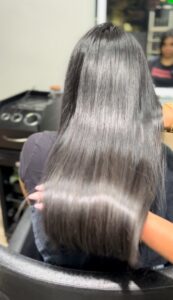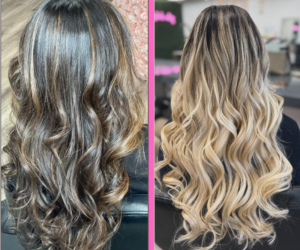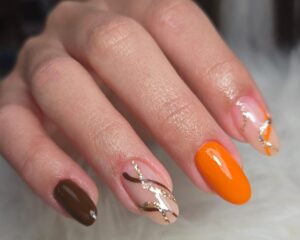Introduction to Gel and Acrylic Nails
In the vibrant world of nail art, gel and acrylic nails stand out as two of the most popular choices for those seeking to enhance the beauty and durability of their nails. Both methods offer unique advantages and have garnered a loyal following. Understanding the fundamental differences between these two types of artificial nails can guide you in making an informed decision that aligns with your aesthetic desires and lifestyle needs.
Acrylic nails are a classic choice, renowned for their strength and versatility. This technique involves a liquid monomer and a powder polymer that, when combined, create a hard protective layer over the natural nail. Once applied, the mixture hardens through exposure to air, forming a robust extension that can be sculpted into various shapes and lengths. Acrylic nails are favored for their durability, making them an excellent option for those who engage in rigorous activities but still wish to maintain flawless nails.
Gel nails, on the other hand, offer a more modern approach. This method utilizes a pre-mixed gel that is applied directly to the nail and cured under a UV or LED lamp, resulting in a glossy, natural-looking finish. Gel nails are praised for their flexibility and lightweight feel, providing a more natural appearance while still offering significant strength. They are ideal for those who prefer a glossy, chip-resistant finish that mimics the look of a natural nail with enhanced durability.
Choosing between gel and acrylic nails ultimately depends on individual preferences, lifestyle needs, and the desired aesthetic outcome. Each type offers its own set of benefits and potential drawbacks, making it imperative to consider what you value most in a nail enhancement solution.
Understanding the Composition of Gel Nails
The allure of gel nails lies in their unique composition, a blend of elegance and durability that transcends traditional nail enhancements. Unlike regular nail polish, gel nails are crafted from a blend of monomers and oligomers, which are then cured under an ultraviolet (UV) or LED light. This curing process transforms the liquid gel into a solid, resilient substance that adheres firmly to the natural nail.
The core components of gel nails are their photoinitiators and polymers. Photoinitiators are essential for the curing process, as they react to the UV or LED light to initiate a chemical reaction that solidifies the gel. This reaction forms a highly cross-linked polymer network, which is responsible for the strength and flexibility of the gel nails. Unlike acrylics, which rely on a liquid and powder system to harden in air, gel nails require light exposure, making them a more controlled and precise option.
The Layers of Gel Application
- Base Coat: The process begins with a base coat that acts as an adhesive layer, promoting a strong bond between the gel and the natural nail.
- Color Gel: Following the base, the color gel is applied, offering a sheen and vibrancy that remains chip-free for weeks.
- Top Coat: The final step involves sealing the color with a top coat, enhancing durability and providing a protective gloss.
By understanding the composition and application process of gel nails, one can appreciate their seamless finish and long-lasting appeal. These elements combine to offer a sophisticated nail solution that caters to both aesthetic desires and practical needs, making gel nails a popular choice among beauty enthusiasts seeking a flawless manicure experience.
Exploring the Components of Acrylic Nails
Acrylic nails, renowned for their durability and versatility, have become a staple in the world of nail enhancements. Understanding the components that make up acrylic nails is essential for both nail enthusiasts and professionals seeking to make informed choices about nail care and design. At the heart of acrylic nails are two fundamental components: the liquid monomer and the powdered polymer. When these two elements are combined, they undergo a chemical reaction that results in a malleable dough-like substance, which is then applied to the natural nail or a nail tip.
The liquid monomer, often composed of ethyl methacrylate (EMA), serves as the reactive agent that binds with the powdered polymer. This monomer is not only crucial for the formation of the acrylic but also plays a significant role in ensuring the finished product’s strength and flexibility. On the other hand, the powdered polymer, typically made of polymethyl methacrylate (PMMA), is available in a variety of colors and finishes, allowing for a vast array of customization options. The choice of polymer can significantly affect the final appearance, offering everything from natural-looking finishes to bold, artistic designs.
Additionally, primers and bonding agents are often used to enhance adherence, ensuring that the acrylic nails last longer without lifting or chipping. These components work in harmony to create a resilient and aesthetically pleasing nail enhancement that can withstand daily wear and tear. By exploring these components, one gains a deeper appreciation for the intricate processes involved in creating stunning acrylic nails, paving the way for informed decisions in nail artistry.
Application Process of Gel Nails
The allure of gel nails lies not only in their glossy finish and durability but also in the meticulous application process that distinguishes them from other nail enhancements. Understanding this process is essential for both enthusiasts and professionals alike, as it provides insight into the precision and artistry involved.
Preparation is Key
Before applying gel nails, the natural nails must be adequately prepared. This begins with a thorough cleaning to remove any oils or residue that might hinder the adhesion of the gel. Nails are then gently buffed to create a rougher surface, allowing the gel to adhere more effectively. Cuticles are carefully pushed back, ensuring a neat and polished final appearance.
Base Coat Application
Once the nails are prepped, the application begins with a thin layer of base coat. This essential step acts as a primer, ensuring a strong bond between the natural nail and the gel. The base coat is cured under a UV or LED lamp, which hardens the gel and sets the foundation for the subsequent layers.
Building Layers with Gel Polish
Following the base coat, layers of gel polish are applied. Each layer is meticulously painted on and cured under the lamp, with the number of coats depending on the desired opacity and color intensity. This curing process transforms the gel from a liquid to a solid state, providing the nails with their signature strength and resilience.
Top Coat and Final Touches
To seal the look, a top coat is applied, adding an extra layer of protection and an attractive shine. This final layer is also cured under the lamp, ensuring the longevity of the manicure. The process concludes with wiping the nails with a cleanser to remove any sticky residue, unveiling a smooth, glossy finish.
The application process of gel nails, with its methodical steps and attention to detail, results in a long-lasting and visually stunning manicure. Such precision ensures that gel nails remain a popular choice for those seeking a durable and aesthetically pleasing nail art solution.
How Acrylic Nails are Applied
The application process for acrylic nails is a meticulous art that transforms natural nails into durable, long-lasting extensions. This procedure begins with the careful preparation of the natural nail, a crucial step to ensure adhesion and longevity. Initially, the nail technician cleanses the nails thoroughly to remove any oils or debris that could impede the bonding process. Following this, the nails are lightly buffed to create a textured surface, allowing the acrylic to adhere more effectively.
Once the nails are prepared, the technician selects the appropriate nail tips, which are affixed to the natural nails using a specialized nail adhesive. These tips serve as the foundation for the acrylic application, determining the desired length and shape. The next step involves the creation of the acrylic blend, a craft in itself. This involves mixing a liquid monomer with a powdered polymer to form a malleable bead. This bead is then meticulously applied over the nail tip and natural nail, sculpting and smoothing it to achieve the desired shape and thickness.
After the acrylic has been shaped, it is left to dry and harden. This curing process is relatively quick, allowing the technician to refine the nails further by filing and buffing them to a smooth, even finish. Finally, a protective topcoat is applied to seal the acrylic and impart a glossy sheen, culminating in a polished, professional look. The entire process of applying acrylic nails combines precision and artistry, ensuring that each set is tailored to the individual’s preferences and style.




